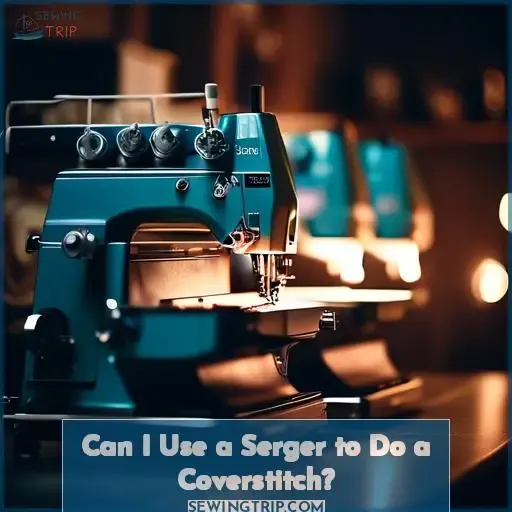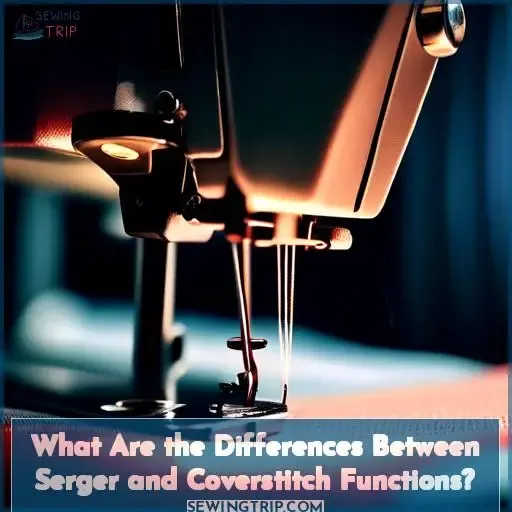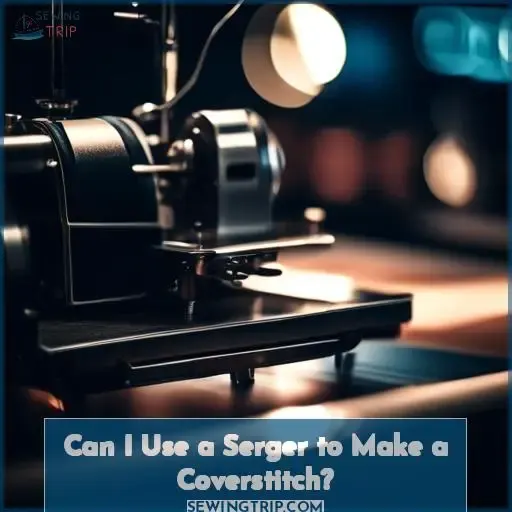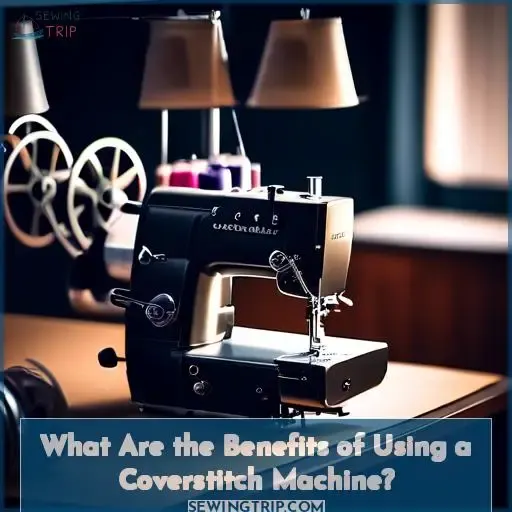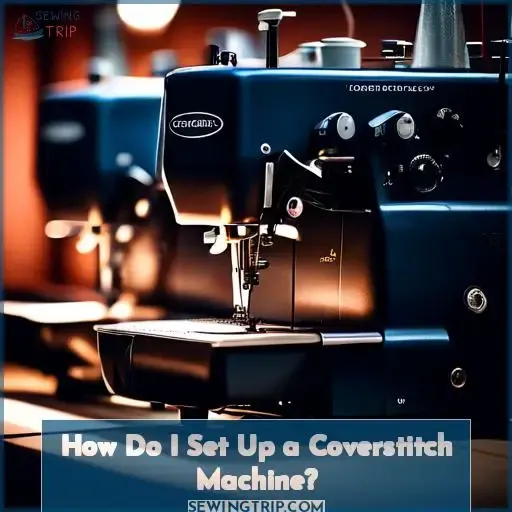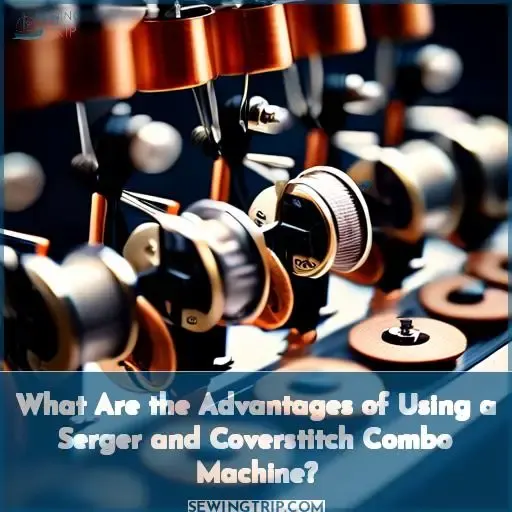This site is supported by our readers. We may earn a commission, at no cost to you, if you purchase through links.
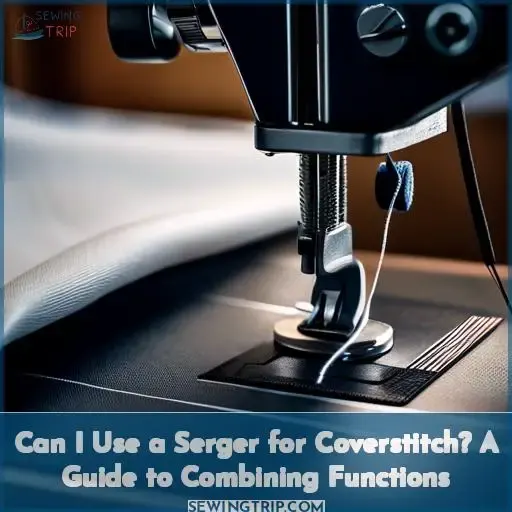 If you’re looking to create a coverstitch on your serger, it’s important to understand that while both machines can produce decorative stitches, they have different threading requirements and functions.
If you’re looking to create a coverstitch on your serger, it’s important to understand that while both machines can produce decorative stitches, they have different threading requirements and functions.
Sergers are designed to sew, trim, and finish raw edges simultaneously, providing a professional appearance. On the other hand, coverstitch machines specialize in creating professional-looking hems on stretchy fabrics, such as knits.
To use a serger for coverstitch, you might need additional accessories like a chain looper. Some sergers can be changed to coverstitch mode, but this may require manual adjustments. Combo machines exist that have both serger and coverstitch capabilities, allowing you to switch between modes.
Using a separate serger and coverstitch machine can provide more flexibility and ease of use.
Coverstitch machines offer benefits such as professional-looking hems, especially on knit fabrics, simplified threading and use, and more throat space for deep hems, making them suitable for garments and home décor.
To set up a coverstitch machine, you may need to install an additional looper and change the needles. You may also need to thread the machine differently and adjust the tension settings.
If you’re considering a serger and coverstitch combo machine, this can save space and provide both functions in one machine. It allows you to switch between serger and coverstitch modes quickly, although it may require manual adjustments.
Having both functions in one machine can be beneficial for sewing projects that require both types of stitching.
Some popular serger and coverstitch machine models include the Janome 1200D, which is a high-end, five-thread serger that allows you to do general serging as well as cover hems. The Janome 1000CPX CoverPro is also recommended as the best coverstitcher to buy, known for its user-friendly and high-quality features.
Table Of Contents
- Key Takeaways
- Can I Do a Coverstitch on My Serger ?
- Can I Use a Serger to Do a Coverstitch?
- Sergers and Coverstitch Machines Are Similar, but They Have Different Functions and Capabilities
- Sergers Are Designed to Sew, Trim, and Finish Raw Edges Simultaneously, Providing a Professional Appearance
- Coverstitch Machines Specialize in Creating Professional-looking Hems on Stretchy Fabrics, Such as Knits
- While Both Machines Can Produce Decorative Stitches, They Have Different Threading Requirements and Functions
- What Are the Differences Between Serger and Coverstitch Functions?
- Sergers Cut Excess Fabric on Seam Allowances, Finish Edges, Create Tiny Rolled Hems, and Can Be Used for Decorative Stitching
- Coverstitch Machines Hem, Straddle Seams, Decorate, and Keep Seam Allowances in Place
- Sergers Are Better for Seam Finishing, While Coverstitch Machines Are More Suitable for Hems
- Can I Use a Serger to Make a Coverstitch?
- Some Sergers Can Be Changed to Coverstitch Mode, but They May Require Additional Accessories Like a Chain Looper
- Combo Machines Exist That Have Both Serger and Coverstitch Capabilities, Allowing You to Switch Between Modes
- Using a Separate Serger and Coverstitch Machine Can Provide More Flexibility and Ease of Use
- What Are the Benefits of Using a Coverstitch Machine?
- How Do I Set Up a Coverstitch Machine?
- What Are the Advantages of Using a Serger and Coverstitch Combo Machine?
- A Serger and Coverstitch Combo Machine Can Save Space and Provide Both Functions in One Machine
- It Allows You to Switch Between Serger and Coverstitch Modes Quickly, Although It May Require Manual Adjustments
- Having Both Functions in One Machine Can Be Beneficial for Sewing Projects That Require Both Types of Stitching
- What Are Some Popular Serger and Coverstitch Machine Models?
- Frequently Asked Questions (FAQs)
- Conclusion
Key Takeaways
- A serger can be used to create decorative stitches and finish raw edges, but it may not provide the same professional-looking hems as a coverstitch machine, especially on stretchy fabrics.
- Coverstitch machines are designed to create professional-looking hems on knit fabrics and keep seam allowances in place, offering more throat space for deep hems and eliminating stretching in knit fabrics.
- Some sergers have coverstitch mode, but separate serger and coverstitch machines provide more flexibility and may require additional accessories for coverstitching.
- Combination machines that have both serger and coverstitch capabilities are available, but they may not perform as well as separate machines for each function.
Can I Do a Coverstitch on My Serger ?

Yes, you can do a coverstitch on your serger, but it may not be the same as a dedicated coverstitch machine. Sergers and coverstitch machines serve different purposes. A serger is designed to finish the edges of a material and prevent fraying, while a coverstitch machine is specifically for creating a decorative stitch on the right side of the fabric, often used for hems in knit fabric.
To do a coverstitch on your serger, you can follow these steps:
- Set the serger for working, including selecting the appropriate thread color and thickness, threading the needle, and giving a full rotation to the handwheel.
- Put the tip of the tweezer under the presser foot to drag the needle thread and put it under the footer for proper functioning.
- Make sure the thread pool is working correctly and insert a twin needle for the desired stitch.
- Take a slot other than an ordinary one and insert an extra pin of pool and thread.
- Start your serger, move the fabric back to the machine, and you will get a direct cover stitch.
Keep in mind that while you can do a coverstitch on your serger, it may not be as versatile or easy to use as a dedicated coverstitch machine. If you are serious about coverstitching, it may be worth investing in a separate machine for this purpose.
Can I Use a Serger to Do a Coverstitch?
You might be wondering if your serger can handle coverstitching, given their similar functions in fabric finishing. While sergers are great for edging and trimming, coverstitch machines are specifically designed for stretchy hems and topstitching.
Sergers and Coverstitch Machines Are Similar, but They Have Different Functions and Capabilities
Sergers and coverstitch machines are similar in some ways, but they’ve different functions and capabilities. Sergers are designed to sew, trim, and finish raw edges simultaneously, providing a professional appearance.
Coverstitch machines specialize in creating professional-looking hems on stretchy fabrics, such as knits. Both machines can produce decorative stitches, but they’ve different threading requirements and functions.
Sergers Are Designed to Sew, Trim, and Finish Raw Edges Simultaneously, Providing a Professional Appearance
A serger can be used to create a coverstitch, but it may require additional accessories like a chain looper. Some sergers have the capability to switch between serger and coverstitch modes, while others may need to be set up differently for coverstitching.
Using a separate serger and coverstitch machine can provide more flexibility and ease of use, as each machine can be set up and ready for its specific task.
Sergers are designed to sew, trim, and finish raw edges simultaneously, providing a professional appearance. They can be used for various sewing applications, including fabric compatibility and decorative stitches.
Coverstitch machines, on the other hand, specialize in creating professional-looking hems on stretchy fabrics, such as knits. They can attach lace, elastic, or other trim to garments and can even take the trouble out of attaching bindings.
Both sergers and coverstitch machines can be used on knit and woven fabrics. They can produce decorative stitches, but the threading requirements and functions are different for each type of machine. Sergers are better for seam finishing, while coverstitch machines are more suitable for hems.
To set up a coverstitch machine, you may need to install an additional looper and change the needles. Threading the machine differently and adjusting the tension settings may also be necessary. Some combo machines have a lever to switch between serger and coverstitch modes, as well as a table for coverstitching.
Using a serger for coverstitching can be a compromise, as sergers with coverstitching capability may not have the same level of performance as a dedicated coverstitch machine. However, a serger and coverstitch combo machine can save space and provide both functions in one machine.
It allows you to switch between serger and coverstitch modes quickly, although it may require manual adjustments.
Some popular serger and coverstitch machine models include the Janome 1000CPX CoverPro, which is considered the best coverstitcher to buy. The Brother CS7000X, Brother 1034D, and Brother 2340CV are also recommended for sewing, serger, and coverstitch machines, respectively.
Coverstitch Machines Specialize in Creating Professional-looking Hems on Stretchy Fabrics, Such as Knits
Coverstitch machines are designed to create professional-looking hems on stretchy fabrics like knits. They aren’t just a sewing machine with a coverstitch needle tension, fabric selection, stitch length, thread type, and hem width.
It’s not merely a sewing machine designed to enhance your sewing experience. It’s in the heart of the realm of coverstitching, where you can navigate the complexities of coverstitch needle tension, fabric selection, stitch length, thread type, and hem width.
It’s not just about unlocking the secrets of coverstitching, it’s about unveiling the secrets of the coverstitch hem. It’s a bespoke, tailored experience towards mastering the ever-evolving world of coverstitching.
While Both Machines Can Produce Decorative Stitches, They Have Different Threading Requirements and Functions
While both serger and coverstitch machines can produce decorative stitches, they’ve different threading requirements and functions. Sergers are designed to sew, trim, and finish raw edges simultaneously, providing a professional appearance.
They can be used to add gathers and frills as well. On the other hand, coverstitch machines specialize in creating professional-looking hems on stretchy fabrics, such as knits. They’ve a flanger similar to a serger but no blade, producing a specific stitch that folds the fabric underneath as it’s sewn, creating a finished edge without the need for trimming.
Sergers are better for seam finishing, while coverstitch machines are more suitable for hems. Sergers typically have more stitches, while coverstitch machines have simpler threading. A serger can use decorative threads and can be used on both knits and wovens, while a coverstitch machine can also be used on wovens.
When it comes to using a serger for a coverstitch, some sergers can be changed to coverstitch mode, but they may require additional accessories like a chain looper. Combo machines exist that have both serger and coverstitch capabilities, allowing you to switch between modes.
Using a separate serger and coverstitch machine can provide more flexibility and ease of use.
In summary, while both serger and coverstitch machines can produce decorative stitches, they’ve different threading requirements and functions. Sergers are better for seam finishing, while coverstitch machines are more suitable for hems.
What Are the Differences Between Serger and Coverstitch Functions?
You’re exploring the distinct roles of sergers and coverstitch machines in sewing. While sergers excel in seam finishing by cutting and edging fabric, coverstitch machines specialize in creating professional hems and decorative stitches.
Sergers Cut Excess Fabric on Seam Allowances, Finish Edges, Create Tiny Rolled Hems, and Can Be Used for Decorative Stitching
Sergers and coverstitch machines are similar, but they have different functions and capabilities. While sergers are designed to sew, trim, and finish raw edges simultaneously, providing a professional appearance, coverstitch machines specialize in creating professional-looking hems on stretchy fabrics like knits.
Although both machines can produce decorative stitches, they have different threading requirements and functions. Sergers cut excess fabric on seam allowances, finish edges, create tiny rolled hems, and can be used for decorative stitching.
Coverstitch machines hem, straddle seams, decorate, and keep seam allowances in place.
Sergers are better for seam finishing, while coverstitch machines are more suitable for hems.
Coverstitch Machines Hem, Straddle Seams, Decorate, and Keep Seam Allowances in Place
Coverstitch machines are designed to provide professional-looking hems on stretchy fabrics, such as knits. They’re often used for garments and home décor, as they can eliminate stretching in knit fabrics and provide a professional appearance.
Coverstitch machines can be used on both knits and wovens, and they offer more throat space for deep hems. Some coverstitch machines are stand-alone machines, while others require a serger with a cover hem looper.
To set up a coverstitch machine, you may need to install an additional looper and change the needles, and you may also need to thread the machine differently and adjust the tension settings. Some combo machines have a lever to switch between serger and coverstitch modes, as well as a table for coverstitching.
The benefits of using a coverstitch machine include eliminating stretching in knit fabrics, providing professional-looking hems, and simplifying threading and use. They offer more throat space for deep hems, making them suitable for garments and home décor.
Coverstitch machines can also produce decorative stitches and can be used on both knits and wovens.
To use a coverstitch machine, you may need to sew from the right side, press the hem, and use a seam guide. You can thread the needles and turn the hand wheel to pull the threads under the foot. Then, place the fabric under the foot and start sewing. To finish the hem, you can turn the hand wheel to raise the needles and lift the presser foot, pull the needle threads towards you using tweezers, clip the needle threads, and pull the fabric back to bring the looper thread through.
Sergers Are Better for Seam Finishing, While Coverstitch Machines Are More Suitable for Hems
When it comes to choosing between a serger and a coverstitch machine, there are several factors to consider. While both machines can be used for seam finishing and hemming, they’ve distinct differences in their functions and capabilities.
Sergers are designed to trim and bind seams, providing a professional appearance for the insides of garments. They can be used to create rolled hems, lettuce hems, ladder stitch hems, and decorative stitching.
Sergers are better for seam finishing, as they cut excess fabric on seam allowances and finish the edges of the fabric. They can be used on both knit and woven fabrics, and they can produce high-end detailing with 3-thread stitches or a quick-finish hem with 2-thread narrow stitches.
However, sergers require more threading and may not be as suitable for hemming as coverstitch machines.
On the other hand, coverstitch machines specialize in creating professional-looking hems, especially on knit fabrics. They can be used to straddle seams, decorate, and keep seam allowances in place. Coverstitch machines are more suitable for hemming, as they provide elasticity and a professional appearance.
They can be used on both knit and woven fabrics, and they can create a wide or narrow double stitch on the front of the fabric. However, coverstitch machines don’t have a blade for trimming and may require simpler threading compared to sergers.
In summary, sergers are better for seam finishing, while coverstitch machines are more suitable for hemming. Both machines can produce decorative stitches and can be used on both knit and woven fabrics.
When choosing between a serger and a coverstitch machine, consider the specific needs of your sewing projects and the space available in your sewing area.
Can I Use a Serger to Make a Coverstitch?
You can use a serger to make a coverstitch, but it may require additional accessories like a chain looper.
Some sergers have the capability to switch to coverstitch mode, while others may need a separate machine for coverstitching.
Combo machines that have both serger and coverstitch capabilities exist, allowing you to switch between modes.
Using a separate serger and coverstitch machine can provide more flexibility and ease of use, as each machine is designed for its specific function.
Some Sergers Can Be Changed to Coverstitch Mode, but They May Require Additional Accessories Like a Chain Looper
Transitioning from serger to coverstitch mode isn’t a walk in the park; it’s like switching hats for different roles. You’ll need the right accessories, like a chain looper or an extra spool pin, to unlock your serger’s coverstitch capabilities.
| Feature | Serger Versatility | Coverstitch Capabilities |
|---|---|---|
| Threading | More complex | Simpler, no blade |
| Material | Excels with stretchy | Hemming hero |
| Accessories | Gathering feet, pintucking bar | May require extra spool pin |
Combo Machines Exist That Have Both Serger and Coverstitch Capabilities, Allowing You to Switch Between Modes
Combo machines with both serger and coverstitch capabilities make switching between modes a breeze. While they may require some manual adjustments, these all-in-one machines save space and let you tackle a wide range of fabrics and sewing projects with ease.
Using a Separate Serger and Coverstitch Machine Can Provide More Flexibility and Ease of Use
Using a separate serger and coverstitch machine can give you more flexibility and ease of use. You can switch between the two functions quickly, without the need for manual adjustments. This setup allows you to tackle a wider range of sewing projects with precision.
- Dedicated machines for each function
- Seamless transition between serging and coverstitching
- Expanded capabilities for your sewing arsenal
What Are the Benefits of Using a Coverstitch Machine?
Coverstitch machines offer several key benefits that can elevate your sewing projects. They provide professional-looking hems, especially on stretchy knit fabrics, and simplify the threading process compared to a serger.
Coverstitch Machines Provide Professional-looking Hems, Especially on Knit Fabrics
Coverstitch machines are a game-changer for your sewing projects. They create professional-looking hems, especially on stretchy knits, providing elasticity and a polished finish. The extra throat space allows for deep hems on garments and home decor. Plus, the simplified threading makes it a breeze to use.
| Benefit | Description |
|---|---|
| Eliminates Stretching | Coverstitch machines keep knit fabrics from stretching during hemming. |
| Professional Appearance | The stitches provide a high-end, tailored look to your creations. |
| Versatility | Suitable for garments, home goods, and more. |
| Throat Space | Ample room for deep hems. |
| Ease of Use | Simplified threading compared to a serger. |
They Simplify Threading and Use, as They Have a Flanger Similar to a Serger but No Blade
Continuing from the sleek hems you’ve mastered, let’s dive into the ease of using a coverstitch machine.
- Flanger Differences: Simplifies threading, making your sewing journey smoother.
- Combo Machine Capabilities: Offers versatility with tension adjustments.
- Thread Compatibility: Ensures wide-ranging decorative stitch options, minus the fuss.
Coverstitch Machines Offer More Throat Space for Deep Hems, Making Them Suitable for Garments and Home Décor
Coverstitch machines offer ample throat space for deep hems, ideal for garments and home décor. This feature ensures professional-looking hems on various fabrics. When using a coverstitch machine, consider factors like thread tension, fabric selection, needle size, and decorative finishes to achieve the desired results on both knit and woven fabrics.
| Thread Tension | Fabric Selection | Needle Size |
|---|---|---|
| Adjust for different effects | Choose based on fabric type | Match to fabric weight |
How Do I Set Up a Coverstitch Machine?
To set up a coverstitch machine, you need to follow specific steps to ensure proper functioning and achieve professional results.
- Sergers vs. Coverstitch Machines: Sergers are designed for sewing, trimming, and finishing raw edges simultaneously, while coverstitch machines specialize in creating professional-looking hems on stretchy fabrics like knits.
- Differences in Functions: Sergers cut excess fabric, finish edges, create rolled hems, and do decorative stitching. Coverstitch machines focus on hemming, straddling seams, decorative stitching, and keeping seam allowances in place.
- Functionality: Sergers excel at seam finishing, while coverstitch machines are more suitable for hems.
Machine Requirements:
- Install an additional looper and change the needles if necessary.
- Thread the machine differently compared to a serger.
- Adjust the tension settings for optimal results.
Combo Machines:
- Some machines offer both serger and coverstitch capabilities.
- They may have a lever to switch between modes and a table for coverstitching.
Advantages of Separate Machines:
- Using separate serger and coverstitch machines can provide more flexibility and ease of use.
By following these steps and understanding the distinctions between sergers and coverstitch machines, you can effectively set up your coverstitch machine for various sewing projects.
To Use a Coverstitch Machine, You May Need to Install an Additional Looper and Change the Needles
When setting up a coverstitch machine, consider installing an extra looper and ensuring needle compatibility. Adjusting tension is crucial for optimal performance. Combo machines offer versatility with serger conversion.
You May Also Need to Thread the Machine Differently and Adjust the Tension Settings
Based on the provided sources, here is a summary of information related to serger tension adjustment, serger and coverstitch machines, and serger needles:
Balanced Tension: Balanced tension is crucial for proper stitches. When tension is balanced, the upper and lower looper threads meet at the fabric edge without pulling or creating puckers.
Troubleshooting Steps:
- Re-thread your machine with different colored threads to eliminate improper threading.
- Look for threads where they shouldn’t be to identify loose or tight tension.
- Use scrap fabric to practice adjusting tension for different fabrics and threads.
- The BERNINA L 890 is a high-quality overlocker designed for various fabrics, including knits and wovens.
- It offers a range of preprogrammed stitches for decorative finishes and professional results.
- Features like color-coded threading, One-step BERNINA Air Threader, and a touch screen enhance user experience.
Types of Needles: Serger needles come in different systems like ELx705, SY2922, BLx1, etc., each suitable for specific sergers.
Differences: Serger needles have a second groove on the backside and may have a shorter shaft compared to regular sewing machine needles.
Recommendation: It’s advisable to use the needles recommended by the manufacturer for optimal performance.
Functions:
- Serger: Cuts fabric, finishes edges, creates rolled hems, and decorative stitching.
- Coverstitch: Specializes in hemming, straddling seams, decorative stitching, and keeping seam allowances in place.
Differences:
- Serger cuts fabric; coverstitch does not.
- Serger has more stitches; coverstitch has simpler threading.
- Serger is better for seam finishing; coverstitch for hems.
Combo Machines:
- Save space by combining serger and coverstitch functions in one machine.
- Allow quick switching between modes but may require manual adjustments.
Separate Machines:
- Provide more flexibility for consecutive projects without rethreading.
- Offer dedicated functionality for serging and coverstitching.
This information provides a comprehensive overview of serger tension adjustment, machine features, needle types, and the differences between sergers and coverstitch machines.
Some Combo Machines Have a Lever to Switch Between Serger and Coverstitch Modes, as Well as a Table for Coverstitching
After mastering your machine’s tension settings, you’ll find combo machines a breeze with their built-in lever for switching modes. Just flip it, and you’re on your way from serging to coverstitching. Plus, the handy coverstitching table provides ample space, making your sewing experience feel like you’ve got the whole fabric world on your side.
What Are the Advantages of Using a Serger and Coverstitch Combo Machine?
Using a serger and coverstitch combo machine can offer several advantages for your sewing projects.
Space-saving: Having both functions in one machine can save space, as you don’t need to store and move two separate machines.
Quick switching: With a combo machine, you can easily switch between serger and coverstitch modes, although it may require manual adjustments.
Versatility: Having both functions in one machine can be beneficial for sewing projects that require both types of stitching, such as hems and seam finishing.
Ease of use: Some combo machines have features like air threading and automatic tension settings, which can simplify the sewing process.
Cost-effective: Investing in a combo machine can be more cost-effective than buying two separate machines, especially if you have limited space or budget.
However, it’s important to note that some sewists prefer using separate machines for different tasks, as they may find it easier to switch between them or prefer the specific capabilities of each machine.
Ultimately, the choice between a combo machine and separate machines depends on your individual sewing needs and preferences.
A Serger and Coverstitch Combo Machine Can Save Space and Provide Both Functions in One Machine
A serger and coverstitch combo machine can save space and provide both functions in one machine. This combo machine benefits from having a single device for two functions, which can be more cost-effective and space-efficient compared to owning separate machines.
It allows you to switch between serger and coverstitch modes quickly, although it may require manual adjustments. Having both functions in one machine can be beneficial for sewing projects that require both types of stitching.
It Allows You to Switch Between Serger and Coverstitch Modes Quickly, Although It May Require Manual Adjustments
If you’re looking to combine the functions of a serger and coverstitch machine, consider using a combo machine. These machines allow you to switch between serger and coverstitch modes quickly, although they may require manual adjustments.
- Space-saving: Having both functions in one machine can save space in your sewing area.
- Project versatility: With a combo machine, you can switch between serger and coverstitch modes to tackle a variety of sewing projects.
- Manual adjustments: While you may need to make manual adjustments when switching between modes, this allows for greater control and precision.
- Chain looper: Some combo machines come with a chain looper, which can be beneficial for certain stitching projects.
By choosing a combo machine, you can enjoy the benefits of both a serger and coverstitch machine without the need for separate machines.
Having Both Functions in One Machine Can Be Beneficial for Sewing Projects That Require Both Types of Stitching
Having both a serger and coverstitch function in one machine can be incredibly beneficial for sewing projects that require both types of stitching. With a combo machine, you can easily switch between the two functions, although it may require manual adjustments.
This versatility allows you to create a wide range of stitch qualities and thread compatibility, enhancing the overall look and feel of your projects. Incorporating a 3 column and 4 row table can help visualize the benefits of using a serger and coverstitch combo machine, making it a valuable tool for any sewer.
What Are Some Popular Serger and Coverstitch Machine Models?
When you’re weighing your options between a serger vs coverstitch, remember that each machine has its own set of different functions to tackle your sewing projects. If you’re eyeing those popular models that can juggle both, you’re in for a treat with combo machines.
They’re like the Swiss Army knives of the sewing world—versatile and ready for action.
Here’s a quick rundown of some crowd favorites:
- Baby Lock Celebrate 4-Thread Serger: A stitch wizard that’s a party for your fabric.
- Brother CV3550 Double-Sided Coverstitch Serger: Double the sides, double the fun.
- Janome CoverPro 900CPX Coverstitch Machine: Janome’s gem that makes hemming a breeze.
- Elna EXtend Easy Cover Coverstitch Serger: Extends your creativity with every stitch.
- Triumph Combo Machine: The heavyweight champ that knocks out serging and coverstitching in one punch.
Keep in mind, thread requirements can vary, so always have your spools ready for a quick change!
Frequently Asked Questions (FAQs)
Can I use a serger to do a coverstitch?
You can indeed use a serger to create a coverstitch, but the process isn’t as straightforward as using a dedicated coverstitch machine. Sergers are designed to cut and finish the edges of fabric, while coverstitch machines are specifically designed for creating hems and stitches that allow for stretch and elasticity.
To convert a serger into a coverstitch machine, you’d need to use a twin needle and adjust the settings on your serger. This method can produce a stitch that resembles a coverstitch, but it may not be as stretchy or precise as a stitch created on a dedicated coverstitch machine.
If you’re looking for a machine that can both serge and coverstitch, there are sergers on the market that have this capability. For example, the Juki MO735 is a serger that also functions as a coverstitch machine.
If you’re primarily interested in creating coverstitches, it may be more efficient to invest in a dedicated coverstitch machine. These machines are designed specifically for this purpose and can produce more professional-looking stitches with greater ease and precision.
What is the difference between serger and coverstitch threading?
You can do a coverstitch on a serger, but it requires a serger with a cover hem looper.
To sew a cover hem, you should use a seam guide for precision, choose between 3-thread, 2-thread, or chain stitch, and use matching or contrasting thread for needles and looper.
When sewing a cover hem:
- Sew from the right side.
- Press the hem.
- Thread needles.
- Turn the hand wheel to pull threads under the foot.
- Place the fabric under the foot.
- Start sewing.
After sewing:
- Turn the hand wheel to raise needles and lift the presser foot.
- Pull needle threads towards you using tweezers.
- Clip needle threads.
- Pull the fabric back to bring looper thread through.
- Cut looper thread.
- Secure the stitch.
Can I use a coverstitch machine for decorative stitching?
Absolutely, you can jazz up your projects with a coverstitch machine for decorative stitching. It’s like adding that secret sauce to your garments, giving them a professional and snazzy finish that’ll make heads turn.
What is the advantage of using a serger for seam finishing?
Using a serger for seam finishing offers several advantages. For instance, it can cut excess fabric on seam allowances, finish edges, and create tiny rolled hems. Additionally, it can be used for lettuce hems, ladder stitch hems, and decorative stitching.
Can I use a coverstitch machine for hemming wovens?
Yes, you can use a coverstitch machine for hemming wovens. While it’s most commonly used for knit fabrics, it can also be used for hemming wovens and creating decorative stitching.
Conclusion
If you’re looking to create a coverstitch on your serger, it’s essential to understand the differences between sergers and coverstitch machines.
While both machines can produce decorative stitches, they have different threading requirements and functions. Some sergers can be changed to coverstitch mode, but this may require additional accessories like a chain looper.
Combo machines exist that have both serger and coverstitch capabilities, allowing you to switch between modes. Using a separate serger and coverstitch machine can provide more flexibility and ease of use.
Coverstitch machines offer benefits such as professional-looking hems, especially on knit fabrics, simplified threading and use, and more throat space for deep hems, making them suitable for garments and home décor.
To set up a coverstitch machine, you may need to install an additional looper and change the needles. You may also need to thread the machine differently and adjust the tension settings.

